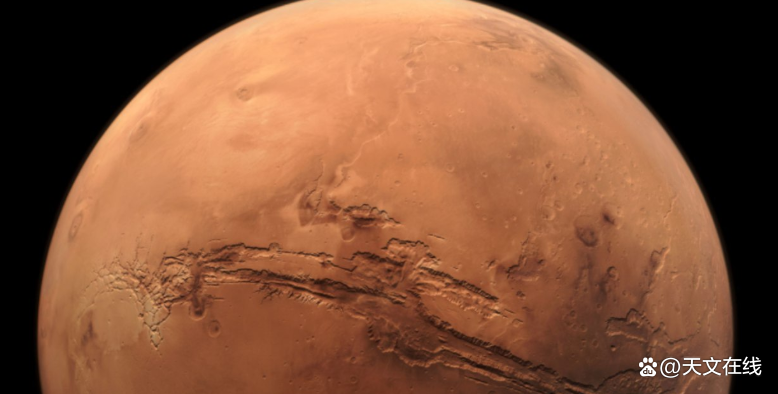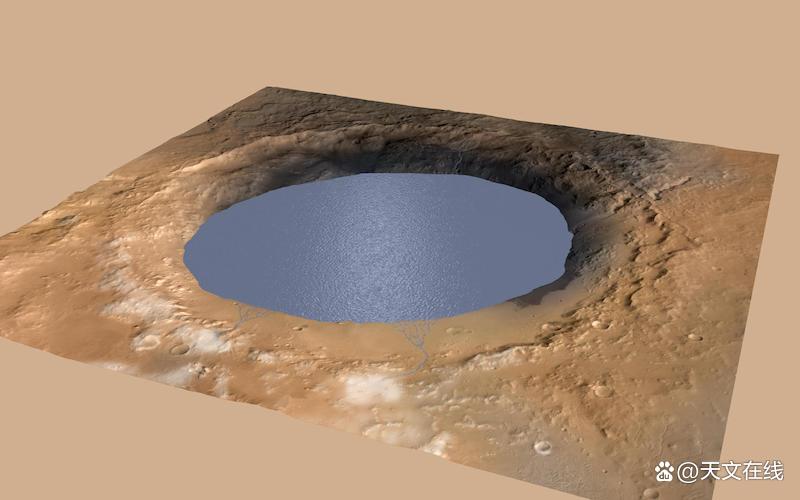New studies have shown that Mars was a world full of water?Is this true?
Author:Astronomy online Time:2022.06.21
How did the flooding lake affect Mars's landform

This map shows the Lusov Valley (white line), which is a canyon (white outline) formed by the water overflow of the lake in the Balana basin. This is just one of the many valleys caused by the flood of the lake on the early Mars. The picture comes from the American Astronaut/Goda Aerospace Flight Center/Jet Promotion Laboratory/Institute of Planet Sciences at the University of Arizona.
Hundreds of billions of years ago, Mars was located in lakes and rivers. Many ancient river valleys can still be seen to this day, which proves that Mars was used to be a obvious humid world. Today, scientists have discovered some new clues about how these valleys are formed: flooding lakes.

According to a new study led by the University of Texas, Timothy A. Gucci, at least 25%of the valleys are caused by the flood of the lake, that is, the water level in the lake exceeds the edge of the lake. Similar to the flood default and breaking the dam.
As a result, huge floods occurred, and the valley was eroded on the surrounding land.
Land lake
Multiple rail aircrafts, landigators and roaming cars have confirmed that before Mars loses most of the atmosphere and temperature and became the cold and dry world we saw today, there were rich lakes and rivers on Mars in the early days. Although a recent study shows that most water is locked in the minerals of the crust, the whereabouts of most water are still controversial.

However, the new discovery shows that the surface of Mars was very humid, so that the lakes often overflowed. How much change can bring billions of years!
Alexander Morgan, Alexander Morgan, at the Institute of Planet Science (PSI):
We found that at least a quarter of the total erosion of Mars Valley was caused by the flood of the lake. Considering that the valley formed by the flood of the lake only accounts for only 3%of the total length of the Mars valley, such high numbers are particularly noticeable. The reason for this difference is that the export canyon is obviously deeper than other valleys. These floods will shape the overall terrain of Mars and affect the flow path of other valleys. Our results did not deny the importance of early Martian precipitation. On the contrary, liquid water must maintain a long and stable time so that the lake can fill the river at the entrance.

Early humid Mars flooding lakes
As described in the paper, in the period of Mars humid, the flood of lake seems to be very common:
In the early days of Mars, there was an active hydrological cycle, including flowing liquid water, which eroded the valley and filled the lake. More than 200 lakes in these lakes are full of water, breaking through the closed terrain, causing catastrophic floods and incisions of exporting canyons.

Geologist Timoshi A. Guqi at the University of Texas leading a new study on the proliferation of early Mars lakes. The picture comes from the University of Texas University of Austin.
Seeing so much water was washed down from the lake and eroded the vast valley, it must be quite spectacular. Now, those valleys and canyons are extremely dry, even more dry than the desert on the earth.
Draw the map of lakes and valleys
So how do researchers determine so many floods on Mars? They use Mars's global map to determine which valleys are formed by flooding lakes. They let the algorithm to calculate the volume of the valley's eroded, and then compare the volume of the canyon formed by the flooding of the lake with other valleys. As Morgan explained:
For a long time, people generally believe that some valleys on Mars are formed by the flood of lakes, but our research is the first global analysis of Mars. Previous research believes that the differences between the valleys on the Mars and the river valleys on the earth prove that the landform of Mars is formed by the process outside the surface water, such as groundwater or glacier erosion. But our research results show that many valleys on Mars are actually more similar to the catastrophic floods on the earth, such as those floods in the northwestern valleys in the northwestern United States in the last period of the last ice period.

The Osuga Canyon group is a set of complex ancient rivers in many rivers on Mars. New studies have shown that at least a quarter of such rivers or valleys are caused by floods caused by flooding lakes. The picture comes from European Aerospace/German Aerospace Center/Berlin Free University/New Scientist.
Guqi added:
If we consider how the sedimen moves on the surface of Mars, then the flood of lakes is a very important process that sediments move in Mars globally. This is a bit of surprising result, because for a long time, they have been considered an abnormal result for a long time.

Climate change on Mars
The results of the research not only provide scientists with clues about the water on Mars, but also provide climates from warm and humid to cold and dry clues. When Mars has a dew flowing with nature, how does it become so unsuitable for living? No one has ever questioned that Mars has had a lot of water, but the problem is not whether Mars has changed, but how it changes. Morgan said:
However, almost everyone agreed that the early Mars environment has gone through huge climate change. During the dry period, impact pits and volcanic activities disrupt the previous rivers formed, which actually formed a dam. When the climate warms to the degree of stability of the liquid water on the surface, a large amount of floods will occur because it must create a new flow path in the meteorite pit. If the flood of lakes is not an important driving factor for early Mars erosion, this will be an incredible discovery. Lakes used to be very common on Mars, just like the lake of the Galf Meteorite Panels described by this artist. The picture comes from the American Astronaut/California Institute of Technology Jet Promotion Laboratory/European Space Administration/German Aerospace Center/Berlin Free University/MSSS.

A cold world
Floods may have passed, but there are still a lot of ice -shaped water on Mars. Not only in the poles, but also carbon dioxide (dried ice), but also the same. Another recent study shows that dust can help melt some ice layers under the table and produce a relatively small amount of liquid water. There may be salt water in some places. In 2018 and 2020, scientists reported that a lake was found under the Antarctic ice cover. However, a recent study shows that these lakes are actually composed of other substances such as salt ice (ice melted ice) or clay.
The wet world is now a cold, frozen and dry world.
Summary: A new study of the ancient Mars Valley showed that at least a quarter of which was caused by the floods that overflowed with a lake in billions of years ago.
By: Paul Scott Anderson
Fy: Lan Duoduo
If there is related content infringement, please contact the author to delete after the work is released
Reprinted, please obtain authorization, and pay attention to maintaining integrity and indicating the source
- END -
CCTV launched the first large immersive digital interaction space to experience the fantasy journey of Sanxingdui

Science Fiction Network June 17 (Liu Yazhu) Recently, CCTV launched the first larg...
From black and white to color, Harbin Institute of Technology takes you to appreciate the beauty of the micro -world!

Beauty, everywhereAs long as you have the eyes that are good at discoveringHave yo...